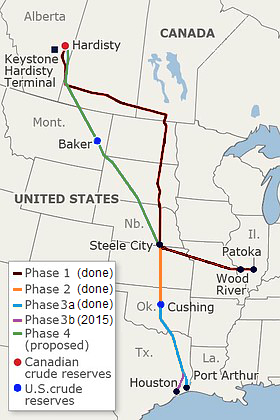You are hereBlogs / Steve Horn's blog / For First Time, TransCanada Says Tar Sands Flowing to Gulf in Keystone XL South
For First Time, TransCanada Says Tar Sands Flowing to Gulf in Keystone XL South
Cross-Posted from DeSmogBlog
TransCanada admitted for the first time that tar sands oil is now flowing through Keystone XL's southern leg, now rebranded the Gulf Coast Pipeline Project. The company confirmed the pipeline activity in its 2014 quarter one earnings call.
Asked by Argus Media reporter Iris Kuo how much of the current 300,000-400,000 barrels per day of oil flowing from the Cushing, Oklahoma to Port Arthur, Texas pipeline is tar sands ("heavy crude," in industry lingo), TransCanada CEO Russ Girling confirmed what many had already suspected.
"I don’t have that exact mix, but it does have the ability to take the domestic lights as well as any heavies that find a way down to the Cushing market, so it is a combination of the heavies and the lights," said Girling. "I just don’t know what the percentage is."
The Keystone Pipeline System — of which Keystone XL's northern leg is phase four of four phases — is and always has been slated to carry Alberta's tar sands to targeted markets. So the announcement is far from a shocker.

Image Credit: Wikimedia Commons
More perplexing is why it took so long for the company to tell the public that tar sands oil now flows through the half of the pipeline approved via a March 2012 Executive Order by President Barack Obama.
"Oil is Oil"
When DeSmogBlog reported TransCanada had begun injecting oil into the pipeline's southern leg in December, the company would not reveal what type of oil it was.
"As you’ve likely seen me quoted before, oil is oil and this pipeline is designed to handle both light and heavy blends of oil, in accordance with all U.S. regulatory standards," TransCanada spokesman Shawn Howard told DeSmogblog at the time.
"I am not able to provide you the specific blend or breakdown as we are not permitted (by our customers) from disclosing that information to the media. There are very strict confidentiality clauses in the commercial contracts we enter into with our customers, and that precludes us from providing that."
Now, though, it appears the company has let the proverbial cat out of the bag.
"Texas Bound and Flyin'"
In the first quarter of 2014, Keystone XL's southern half has opened up the floodgates for what was once a glut of oil in Cushing to reach Gulf Coast refineries at record levels.
To borrow the title of Jerry Reed's 1980 country song classic, it's "Texas Bound and Flyin.'" An April 17 Energy Information Agency communiqué lays out the dirty details.
"The main driver of the recent crude oil inventory builds on the [Gulf Coast] is start-up of TransCanada's [Gulf Coast Pipeline] which runs from the Cushing, Oklahoma storage hub to the Houston area," explained the EIA. "In late January, TransCanada completed the first delivery of crude oil via [Gulf Coast Pipeline] to [Gulf Coast] refineries."

Chart Credit: U.S. Energy Information Agency
In short, the glut of oil has teleported from Cushing to Texas in the aftermath of Keystone XL's southern leg opening for business in January, as explained in another EIA March 27 update.
"Crude oil inventories at Cushing, Oklahoma, the primary crude oil storage location in the United States, decreased 13 million barrels (32%) over the past two months," the EIA wrote. "On March 21, Cushing inventories were less than 29 million barrels, more than 20 million barrels lower than a year ago."

Chart Credit: U.S. Energy Information Agency
Northern Leg and Rail
Keystone XL's northern leg, or what many know simply as Keystone XL, also came up on the earnings call.
Girling voiced frustration with how long the process has taken and with President Obama's April 18 announcement to delay a decision on the northern leg until after the 2014 mid-term elections.
"In our view this delay is inexplicable. The first leg of our Keystone system took just over 600 days to review and approve," said Girling. "Now after more than 2,000 days, five exhaustive environmental reviews and over 17,000 cases of scientific data, the review process continues to be delayed."
The prospect of moving tar sands oil by rail to Cushing was also discussed on the call.
"Our customers have asked us to look at a rail bridge between Alberta and U.S. points," Bill Taylor, TransCanada's Executive Vice-President and President of Energy, said on the call. "I’d say that since the delays, the intensity of those calls has gone up quite substantially."
Girling echoed Taylor in discussing his company's tar sands oil-by-rail chess move.
"It is something...that we can move on relatively quickly," Girling stated. "We’ve done a pretty substantial amount of work at the terminal end and mostly at the receipt and delivery points and that’s really what our key role in here would be.
"You know a lot of the tankage is already in place so it’s a matter of building rail sidings and those kinds of things which aren’t overly complicated and we have spent some time engineering those things."
Debate Continues, TransCanada Forges Ahead
The debate over TransCanada's Phase Four (Keystone XL's northern leg) continues apace.
But, TransCanada's quarter one earning's call makes one thing clear: the company is firing ammo from many angles to move tar sands to market with or without the oft-discussed pipeline.
As Oil Change International executive director Steve Kretzmann put it in a press release after President Obama punted on the pipeline decision until after the 2014 elections, "While the oil industry and their paid Representatives in Congress are likely to scream, it's worth keeping in mind that...crude oil inventories on the Gulf Coast are at record levels."
- Steve Horn's blog
- Login to post comments
-

- Email this page
- Printer-friendly version






